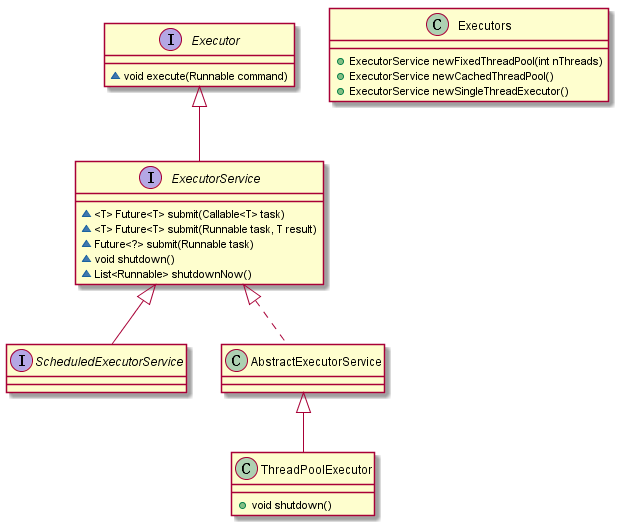03.Executors
Executors 详解
并发 API 引入了 ExecutorService 作为一个在程序中直接使用 Thread 的高层次的替换方案。Executos 支持运行异步任务,通常管理一个线程池,这样一来我们就不需要手动去创建新的线程。在不断地处理任务的过程中,线程池内部线程将会得到复用,因此,在我们可以使用一个 Executor Service 来运行和我们想在我们整个程序中执行的一样多的并发任务。


Executor, ExecutorService 和 Executors

正如上面所说,这三者均是 Executor 框架中的一部分。Java 开发者很有必要学习和理解他们,以便更高效的使用 Java 提供的不同类型的线程池。总结一下这三者间的区别,以便大家更好的理解:
- Executor 和 ExecutorService 这两个接口主要的区别是:ExecutorService 接口继承了 Executor 接口,是 Executor 的子接口
- Executor 和 ExecutorService 第二个区别是:Executor 接口定义了
execute()方法用来接收一个Runnable接口的对象,而 ExecutorService 接口中的submit()方法可以接受Runnable和Callable接口的对象。 - Executor 和 ExecutorService 接口第三个区别是 Executor 中的
execute()方法不返回任何结果,而 ExecutorService 中的submit()方法可以通过一个 Future 对象返回运算结果。 - Executor 和 ExecutorService 接口第四个区别是除了允许客户端提交一个任务,ExecutorService 还提供用来控制线程池的方法。比如:调用
shutDown()方法终止线程池。 - Executors 类提供工厂方法用来创建不同类型的线程池。比如:
newSingleThreadExecutor()创建一个只有一个线程的线程池,newFixedThreadPool(int numOfThreads)来创建固定线程数的线程池,newCachedThreadPool()可以根据需要创建新的线程,但如果已有线程是空闲的会重用已有线程。
下表列出了 Executor 和 ExecutorService 的区别:
| Executor | ExecutorService |
|---|---|
| Executor 是 Java 线程池的核心接口,用来并发执行提交的任务 | ExecutorService 是 Executor 接口的扩展,提供了异步执行和关闭线程池的方法 |
| 提供 execute()方法用来提交任务 | 提供 submit()方法用来提交任务 |
| execute()方法无返回值 | submit()方法返回 Future 对象,可用来获取任务执行结果 |
| 不能取消任务 | 可以通过 Future.cancel()取消 pending 中的任务 |
| 没有提供和关闭线程池有关的方法 | 提供了关闭线程池的方法 |
Hello World
下面是使用 Executors 的第一个代码示例:
ExecutorService executor = Executors.newSingleThreadExecutor();
executor.submit(() -> {
String threadName = Thread.currentThread().getName();
System.out.println("Hello " + threadName);
});
// => Hello pool-1-thread-1
Executors 必须显式的停止,否则它们将持续监听新的任务。ExecutorService 提供了两个方法来达到这个目的:shutdwon() 会等待正在执行的任务执行完而,shutdownNow() 会终止所有正在执行的任务并立即关闭 executor。
try {
System.out.println("attempt to shutdown executor");
executor.shutdown();
executor.awaitTermination(5, TimeUnit.SECONDS);
}
catch (InterruptedException e) {
System.err.println("tasks interrupted");
}
finally {
if (!executor.isTerminated()) {
System.err.println("cancel non-finished tasks");
}
executor.shutdownNow();
System.out.println("shutdown finished");
}
